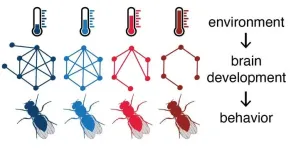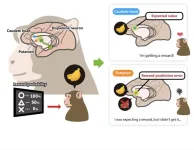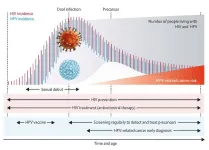(Press-News.org) The rate of development of poikilothermic animals, such as insects, fish, and reptiles, is determined by environmental temperature. A research team at Johannes Gutenberg University Mainz (JGU) has recently demonstrated how temperature can affect brain development in fruit flies. "In the area of the brain we examined, neurons formed more synapses and connected to more synaptic partners at lower temperatures," stated Dr. Carlotta Martelli, head of the team at the Institute of Developmental Biology and Neurobiology of JGU. In their study, the scientists focused on the olfactory circuit of Drosophila melanogaster, because the sense of smell determines important behavioral patterns in these flies and is essential for their survival. They found that the temperature to which the insects are exposed to during the pupal stage has an effect not only on brain development but also on odor-driven behavior.
Metabolic theory for brain wiring at different temperatures
Temperature is the environmental factor with the most extensive impact on the biology of living organisms, as it determines the rates of all biophysical reactions. On the one hand, development is more rapid at higher temperatures while, at the same time, temperature can also have effects on animal behavior. In bees, for example, even small variations in environmental temperature can affect key areas of the brain responsible for learning. A deeper knowledge of the correlations between temperature and development is important to be able to predict the consequences of changes in temperature on the behavior of wild animals, but also to better understand the processes underlying the development of poikilothermic animals, i.e., those with variable body temperatures.
In the case of Drosophila, it was discovered some years ago that the number of synapses between neurons in the visual system increased when the temperature during their development was lower. Dr. Carlotta Martelli's team now decided to study the insects' olfactory circuit and determine the effect of different temperatures. For this purpose, flies were developed at either 18 degrees Celsius or 25 degrees Celsius during the pupal stage, i.e., between larval stage and emerged adult insect, which is when brain wiring happens. Martelli and her team used genetic techniques to detect the synaptic partners of a specific type of neuron in the adult fly brain. A count showed that the animals that had developed at 18 degrees Celsius had more than twice as many postsynaptic neurons as those flies that had developed at 25 degrees Celsius. Greater numbers of connections were apparent at all levels of the olfactory circuit in the insects' brains.
"In order to explain this outcome, we devised a theory based on the assumption that there are slightly divergent metabolic conditions for the growth of the insect body as a whole and the development of the brain," added Martelli, whose research combines theoretical physics and neurobiology. In other words, the metabolic processes are somewhat different in neurons than in other body cells. Martelli and her team assumed that metabolism is more rapid in the brain at lower temperatures than in the other parts of the body. "We have been able to confirm our theoretical conjectures in other experiments," Martelli said. However, direct evidence to support this hypothesis regarding the role of metabolism is still lacking. The researchers are currently analyzing the expression of relevant genes during development to find an answer.
Developmental temperature also influences behavior
Furthermore, the researchers reported that if temperature is lowered during the pupal stage, this affects the odor-driven behavior of the adult flies. For the purpose of the experiment, flies aged ten days were exposed to a tiny quantity of butanone, a liquid with a pungent odor that attracts the insects. Flies that developed at 18 degrees Celsius during the pupal phase exhibited greater attraction to this odor than those pupal fruit flies kept at 25 degrees Celsius.
"Although the flies that developed at lower temperature had greater brain connectivity, they did not appear to have better or stronger odor perception," pointed out Martelli. "Measurements of neuronal activity show that odor representation in that part of the brain that is equivalent to the human olfactory bulb was unchanged. We have thus concluded that behavioral changes could well be attributable to connectivity in downstream areas of the brain that control innate behavior," concluded Martelli.
The research was financed by the German Research Foundation (DFG) through the Research Unit RobustCircuit – From Imprecision to Robustness in Neural Circuit Assembly (FOR 5289) and the Institute for Quantitative and Computational Biosciences (IQCB), which was established in early 2024 at Johannes Gutenberg Mainz University. The corresponding article has been published in Science Advances.
Related links:
https://mrtlllab.uni-mainz.de/ – Research group of Dr. Carlotta Martelli at the JGU Institute of Developmental Biology and Neurobiology (IDN)
https://idn.biologie.uni-mainz.de/ – Institute of Developmental Biology and Neurobiology (IDN) at JGU
https://www.blogs.uni-mainz.de/fb10-biologie-eng/ – Faculty of Biology at JGU
https://robustcircuit.flygen.org/ – DFG Research Unit "RobustCircuit – From Imprecision to Robustness in Neural Circuit Assembly" (FOR 5289)
https://iqcb.uni-mainz.de/ – Institute for Quantitative and Computational Biosciences (IQCB) at JGU END
Temperature during development influences connectivity between neurons and behavior in fruit flies
Researchers find more synapses and postsynaptic partners in the brain of Drosophila melanogaster correlating to lower environmental temperature during pupal development
2025-03-12
ELSE PRESS RELEASES FROM THIS DATE:
Are you just tired or are you menopause tired?
2025-03-12
CLEVELAND, Ohio (March 12, 2025)—Multiple menopause symptoms can make women feel fatigued. Hot flashes, sleep problems, pain, and depression are just a few. A new study suggests that heavy or prolonged menstrual bleeding may increase fatigue, which helps to explain why midlife women are two-to-four times more likely to experience debilitating forms of syndromic fatigue. Results of the study are published online today in Menopause, the journal of The Menopause Society.
Most women transitioning through ...
Fluorescent dope
2025-03-12
Kyoto, Japan -- We're all familiar with Pavlovian conditioning, in which a reward-anticipatory behavior follows a reward-predicting stimulus. Perhaps you experience it yourself when passing a café or restaurant and catching a whiff of something delectable.
Behind this mechanism is dopamine released within the striatum, the largest structure of the subcortical basal ganglia, which links motor movements and motivation. Yet it has remained unclear exactly what kind of dopamine signal is transmitted to the striatum to cause this behavior in primates.
In order to understand this dopamine signal, a team of researchers from Kyoto University ...
Meningococcal vaccine found to be safe and effective for infants in sub-Saharan Africa
2025-03-12
University of Maryland School of Medicine (UMSOM) researchers helped conduct an important new global health study that found a vaccine that protects against five strains of meningitis prevalent in sub-Saharan Africa is safe and effective for use in young children beginning at 9 months of age. This study provided evidence that formed the basis for the World Health Organization’s (WHO) decision last year to recommend the pentavalent Men5CV meningitis vaccine for infants ages 9 months and older.
Results of the study were published today in the journal Lancet.
In January 2024, the WHO recommended that all countries in the African meningitis belt introduce Men5CV into their routine immunization ...
Integrating stopping smoking support into talking therapies helps more people quit – new study
2025-03-12
Research from the University of Bath, funded by Cancer Research UK, published on No Smoking Day 2025, shows that integrating smoking cessation support into NHS Talking Therapies for depression and anxiety increases quit rates. This is an important step in addressing the high rates of smoking in this population.
Led by Dr Gemma Taylor at the University of Bath, alongside researchers from several other institutions, the study published in Addiction also found that adding smoking support to mental health treatment didn’t disrupt therapy. Instead, it offered a practical way to tackle mental and physical health together.
About the Study
The trial was conducted across four NHS ...
Breast cancer death rates will rise in elderly EU patients but fall for all other ages
2025-03-12
Death rates from breast cancer will fall in 2025 in every age group in the EU and the UK apart from in EU patients aged 80 years and older. In these older patients, overall mortality rates from the disease are predicted to rise by nearly 10% in 2025.
However, in the UK, breast cancer death rates are expected to decrease by 7% in this age group, compared to rates observed between 2015-2019. In Spain, there is also a 4% decrease in patients aged 80 and over.
These findings are from a new study published in the leading cancer journal Annals of Oncology [1] today (Wednesday), ...
Routine asthma test more reliable in the morning and has seasonal effects, say doctors
2025-03-12
A lung function test used to help diagnose asthma works better in the morning, becoming less reliable throughout the day, Cambridge researchers have found.
Using real world data from 1,600 patients, available through a database created for speeding up research and innovation, the team also found that its reliability differs significantly in winter compared to autumn.
Asthma is a common lung condition that can cause wheezing and shortness of breath, occasionally severe. Around 6.5% of people over six years old in the UK are affected by the condition. Treatments include the use of inhalers or nebulisers to carry ...
Yearly 18% rise in ADHD prescriptions in England since COVID-19 pandemic
2025-03-11
Prescriptions for attention deficit hyperactivity disorder (ADHD) in England have risen 18% year on year since the pandemic. This is higher than previously reported, and masks wide regional variations in prescribing rates, finds research published in the open access journal BMJ Mental Health.
The trends likely reflect growing public and professional awareness of the condition, driven in part by social media, as well as the potential impact of COVID-19, suggest the researchers. But the regional variations point to inequalities in access to care, they add.
ADHD is ...
Public health advice on safety of glycerol-containing slush ice drinks likely needs revising
2025-03-11
Public health advice on the safe consumption of glycerol-containing slush ice drinks, also known as slushees, may need revising, conclude researchers after carrying out a detailed review of the medical notes of 21 children who became acutely unwell shortly after drinking one of these products.
Their findings, published in the journal Archives of Disease in Childhood, show that in each case the child became acutely unwell with a cluster of symptoms soon after drinking a slush ice drink, which the researchers refer to as glycerol intoxication ...
Water aerobics for more than 10 weeks can trim waist size and aid weight loss
2025-03-11
Water/aqua aerobics for 10 or more weeks at a time can trim waist size and aid weight loss, finds a pooled data analysis of the available evidence, published in the open access journal BMJ Open
This type of exercise is particularly effective in overweight/obese women and the over 45s, the analysis indicates.
Global estimates for 2022 indicate that more than 43% of adults worldwide were overweight, and that 504 million women and 374 million men were obese, note the researchers, adding that obesity contributes to an estimated 2.8 million deaths every year.
The buoyancy of water helps reduce joint injuries commonly associated with land based exercise ...
New study in the Lancet HIV highlights gaps in HPV-related cancer prevention for people living with HIV
2025-03-11
A new study published in The Lancet HIV reveals gaps in knowledge surrounding the prevention of HPV-related cancers in people living with HIV and outlines future research priorities. A literature review, conducted by a team of international experts underscores the need for further research and highlights existing disparities in healthcare for this vulnerable population.
HPV-related cancers are preventable, primarily through vaccination. However, a Professor of Epidemiology at the University of Tartu and one of the study’s authors Anneli Uusküla said that the study found a lack of evidence on the effectiveness of ...
LAST 30 PRESS RELEASES:
First Editorial of 2026: Resisting AI slop
Joint ground- and space-based observations reveal Saturn-mass rogue planet
Inheritable genetic variant offers protection against blood cancer risk and progression
Pigs settled Pacific islands alongside early human voyagers
A Coral reef’s daily pulse reshapes microbes in surrounding waters
EAST Tokamak experiments exceed plasma density limit, offering new approach to fusion ignition
Groundbreaking discovery reveals Africa’s oldest cremation pyre and complex ritual practices
First breathing ‘lung-on-chip’ developed using genetically identical cells
How people moved pigs across the Pacific
Interaction of climate change and human activity and its impact on plant diversity in Qinghai-Tibet plateau
From addressing uncertainty to national strategy: an interpretation of Professor Lim Siong Guan’s views
Clinical trials on AI language model use in digestive healthcare
Scientists improve robotic visual–inertial trajectory localization accuracy using cross-modal interaction and selection techniques
Correlation between cancer cachexia and immune-related adverse events in HCC
Human adipose tissue: a new source for functional organoids
Metro lines double as freight highways during off-peak hours, Beijing study shows
Biomedical functions and applications of nanomaterials in tumor diagnosis and treatment: perspectives from ophthalmic oncology
3D imaging unveils how passivation improves perovskite solar cell performance
Enriching framework Al sites in 8-membered rings of Cu-SSZ-39 zeolite to enhance low-temperature ammonia selective catalytic reduction performance
AI-powered RNA drug development: a new frontier in therapeutics
Decoupling the HOR enhancement on PtRu: Dynamically matching interfacial water to reaction coordinates
Sulfur isn’t poisonous when it synergistically acts with phosphine in olefins hydroformylation
URI researchers uncover molecular mechanisms behind speciation in corals
Chitin based carbon aerogel offers a cleaner way to store thermal energy
Tracing hidden sources of nitrate pollution in rapidly changing rural urban landscapes
Viruses on plastic pollution may quietly accelerate the spread of antibiotic resistance
Three UH Rainbow Babies & Children’s faculty elected to prestigious American Pediatric Society
Tunnel resilience models unveiled to aid post-earthquake recovery
Satellite communication systems: the future of 5G/6G connectivity
Space computing power networks: a new frontier for satellite technologies
[Press-News.org] Temperature during development influences connectivity between neurons and behavior in fruit fliesResearchers find more synapses and postsynaptic partners in the brain of Drosophila melanogaster correlating to lower environmental temperature during pupal development


